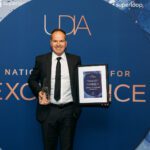A virtual reality simulation of Beacon Island in the Houtman Abrolhos Islands – site of the notorious Batavia shipwreck − will enable members of the public to explore and understand the tiny island’s dramatic place in Western Australian history.
Beacon Virtua is a digital visualisation of the island developed ![]() at the Curtin HIVE and The University of Western Australia (UWA) as part of an Australian Research Council (ARC) Linkage project led by UWA and the Western Australian Museum.
at the Curtin HIVE and The University of Western Australia (UWA) as part of an Australian Research Council (ARC) Linkage project led by UWA and the Western Australian Museum.
The visualisation presents Beacon Island as it was in 2013 and takes users on a tour of key features, from the rudimentary shacks built by fishing families who for decades made the island their home during the annual Abrolhos fishing season, to excavated graves holding the skeletal remains of survivors of the Batavia wreck.
Dr Andrew Woods, Manager of the Curtin HIVE and leader of the Beacon Virtua project, said the visualisation − available as a Google Cardboard app for Android, for Windows and Mac computers and for desktop web browsers – would allow the general public to learn about the island’s history in a highly immersive and engaging way.
“Very few people have been to Beacon Island, so this simulation allows the public at large to gain a very realistic experience of visiting the island,” Dr Woods said.
“People will be able to see the island as it was with an extensive array of fishing shacks, a schoolhouse built by the families for their children – complete with lessons on the table and blackboard − as well as the shallow graves of Batavia survivors who later died on the island.
“It might sound rather macabre, but it is done very tastefully and is an important part of the story of Beacon Island.”
Beacon Virtua was launched at the Curtin HIVE today by Mr Alec Coles, CEO of the Western Australian Museum.
The simulation is an outcome of the ARC Linkage project, Shipwrecks of the Roaring Forties – a maritime archaeological reassessment of some of Australia’s earliest shipwrecks, led by UWA’s Professor Alistair Paterson and the WA Museum’s Dr Jeremy Green. The Beacon Virtua portion of the project was developed at the Curtin HIVE and UWA by Paul Bourke, Nick Oliver and Dr Woods.
Dr Green, Head of the Department of Maritime Archaeology at the WA Museum, said the loss of the Dutch VOC ship Batavia in 1629 off the WA coast, and subsequent mutiny and death of 200 individuals, was one of the most dramatic events in Dutch and Australian shared history.
“The National Heritage-listed sites on the island are some of the earliest European sites in the nation,” Dr Green said.
“The visualisation allows people to see Batavia’s Graveyard, as it was once known, through time − the graves of those who died on the island and the archaeological excavations that revealed them. The buildings of the fishing community that were once there and are now gone can also be viewed at leisure. All of this helps to preserve our heritage for future generations.”
Professor Alistair Paterson, ARC Future Fellow in Social Sciences/Archaeology at UWA, said digital visualisation was emerging as a significant area of research into better methods to record archaeological and heritage places and bring them to widening audiences.
“Heritage sites are increasingly being recorded using innovative digital methods − Beacon Virtua is a great ongoing research experiment into visualisation methods on a National Heritage Listed place,” he said.
The full visualisation includes 3D models of significant sites on the island and more than 120 photographic panorama bubbles that allow users to experience a photorealistic view. Users can step inside the bubbles and look around to see a 360-degree view from each panorama location.
Pop-ups provide information about points of significance and historical background about the island’s Batavia shipwreck past, its recent history as a fishing base, and its future as part of a new national park for WA.
Dr Woods said Beacon Virtua had been created using audio and photography captured during multiple expeditions to the island.
“Several of the 3D models in the simulation have been generated through a technique called photogrammetric 3D reconstruction; a process which uses multiple photographs of an object to build an accurate and detailed 3D model,” Dr Woods said.
“The simulation also gives life to the many seagulls that fly around the island. It seems as if you’re actually on the island − just don’t expect to get your feet wet.”
There are multiple versions available for download including a simplified demonstration version that can be explored within a web browser; the full version (700MB) with full graphics, set of panorama bubbles, 3D models of graves and audio which will run on Windows and Mac computers; and a version that will run on head-mounted displays such as the Google Cardboard VR viewer.
The simulation can be previewed and/or downloaded from www.museum.wa.gov.au/BeaconVirtua.


